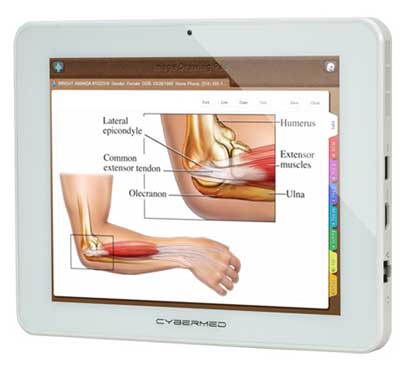|
Cybernet CyberMed T10
Pleasing design and the promise of Windows 8 make this Intel Atom N2600-based medical tablet an interesting look at things to (perhaps) come
(by Conrad H. Blickenstorfer)
The CyberMed T10 medical tablet from Cybernet came to our attention via an April 18, 2012 press release. It said that in partnership with Intel, Cybernet had developed this Windows-based medical tablet, and Intel had invited Cybernet to participate in the China Medical Equipment Fair held in Shenzhen, China April 17-20, 2012 to display the tablet. CMEF, by the way, is the largest medical equipment exhibition in the Asia Pacific region, with more than 2500 companies and 150,000 visitors from 100 countries around the world.

Intel, of course, has been a trend setter in medical tablets for quite some time. Intel's Mobile Clinical Assistant reference platform initially led to Motion Computing's C5 tablet in 2007, and then a number of similar medical tablet designs from Panasonic, Advantech, Arbor, Fujitsu, GammaTech, Winmate, TabletKiosk and others. While some of these designs met with a good degree of success, overall acceptance of medical tablets was not as quick as manufacturers had hoped.
It's 2012 now, and the technological landscape has changed. Thanks to the iPad, the tablet form factor is red-hot and there seems almost endless application in numerous industries. It's been unexpectedly difficult for Android and Windows-based tablets, though, to cash in on the iPad's success, even with vertical market tablet prices way down from when Intel first unveiled the Mobile Clinical Assistant concept.
So what did Cybernet come up with? A product that's quite different from Intel's 2007 reference design with its integrated handle that became the basis for most subsequent MCAs. By comparison, the CyberMed T10 looks — surprise — much more like an iPad with Apple-esque minimal design. It measures 10 x 7.5 inches and has a 9.7-inch 1024 x 768 pixel XGA display with capacitive multi-touch — almost exactly like the original iPad. The CyberMed is a bit thicker (0.6 inches) and heavier (2 pounds), but this is clearly a media tablet era design.
As far as technology goes, the CyberMed is based on the dual-core 1.6GHz Intel Atom N2600 processor and its accompanying NM10 chipset. That's a frugal, competent third-gen Atom design that's perfectly capable of running Windows at an acceptable speed. Performance is further helped along via use of a solid state disk (64 to 256GB available, but you can also have a standard hard disk instead), and there is 4GB of DDR3 RAM. This means that the T10 can run any number of Windows operating systems, including embedded versions and the upcoming Windows 8.
Since medical tablets are meant to improve workflow, ease workloads, and reduce errors, they usually offer various data capture methods, and the CyberMed is no different — you can get it with optional RFID and 1D/2D scanner. There are also dual cameras, each with 2-megapixel resolution.

For connectivity there is a USB 2.0 port, an RJ45 Gigabit Ethernet jack, as well as Intel N6230-based 802.11a/b/g/n WiFi and Bluetooth. No optional WWAN module as far as we can tell, and apparently also no card slots.
In terms of design for medical settings, Cybernet lists a recyclable aluminum and glass enclosure with antimicrobial coating, a fanless design that's easy to clean (though gunk can accumulate in the non-protected ports), and a degree of ruggedness. There isn't a drop spec, the device has a modest operating temperature range of 32 to 104 degrees Fahrenheit, and the front bezel carries IP65 sealing, which doesn't mean much as the back is only IPX1.
Despite the frugal Atom processor and relatively high weight for a tablet of this kind, stated battery life is only 3:40 hours. That is very modest, even though clinical tablets spend a lot of time in their docks. Still, we'd expect twice that by now.
How does the CyberMed T10 compare to the competition? That's hard to say because right now things are a bit in flux. The original generation of Mobile Clinical Assistants was priced in the US$2,500-3,000, i.e. much more than many media tablet era customers are willing to pay for such devices today. This means that the CyberMed is more likely to be compared with some of the more recent Windows 7 tablets, such as the Motion CL900 or the Fujitsu Q550, both of which sports similar specs and start under US$1,000.

Much will also depend on Windows 8. Capacitive multi-touch works wonderfully well with the iOS and Android, but not with Windows 7 where it requires custom applications to even show its potential. Windows 8, though, will have the tablet- and touch-centric Metro interface, and that could exponentially boost the usefulness of tablets such as the CyberMed 10. If that happens, then having been early to market will be a big plus.
|



